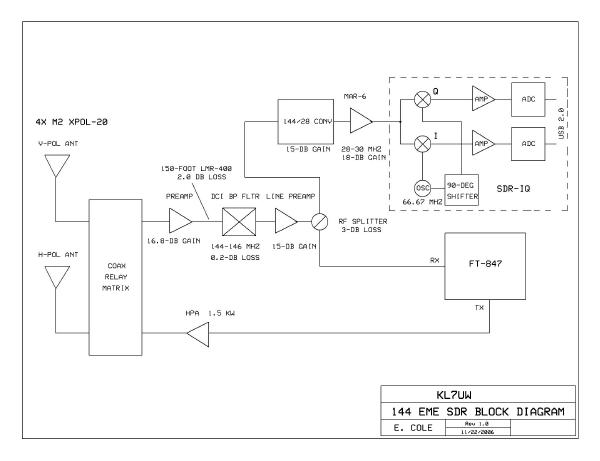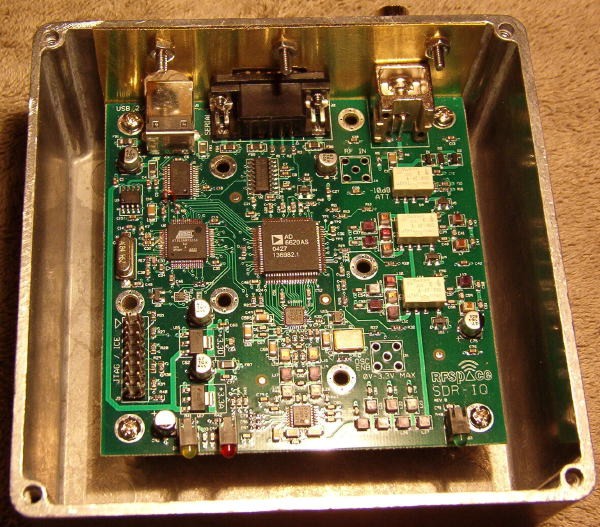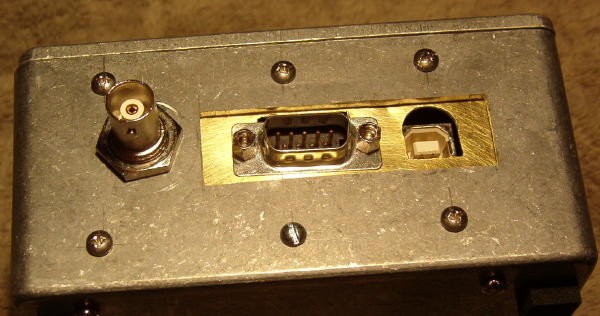Update January 4, 2007 - My SDR-IQ has arrived!
RF Space has just announced a new software defined Receiver, the SDR-IQ. I have ordered
one of the 100 demo pc board units scheduled for shipping in January 2007. The SDR-IQ
appears to be a "little brother" to their SDR-14 and covers 500 Hz to 30 MHz (click to see
larger image).
 I intend to use it mainly for EME and have ordered a 144/28 MHz transverter from Downeast
Microwave to serve as first convertor for the SDR-IQ (operating 28-30 MHz). I decided
to get the DEMI model 144/28K low-power xvtr kit as it has two stages of amplification
for 144 MHz. I briefly looked at DEMI's SDR and microwave (zero-gain) xvtr versions
but was concerned that no 144-MHz receive preamp is included in those units. I also looked
at the 144/28RX receiver converter but reasoned that getting transmit capability for future
use made sense. The 144/28K outputs 10mw adequate to drive most transverters.
I suspect that the SDR-IQ may require additional RF filtering. I expect to add a 28-30 MHz BP filter
between the 144/28 MHz converter and the input of the SDR-IQ. If additional preampflication is required,
I may build a two-stage wideband preamp for the the SDR-IQ (see "A High-Level Accessory Front End
for the HF Amateur Bands", by Sergio Cartoceti, IK4AUY, QEX - Mar/Apr 2003, pp. 45-56).
For use on 2 meter EME I have already a tower-mounted preamp, followed by 170-foot of LMR-400
coax which feeds a DCI-145-2H BP filter into a MOSFET preamp and then to the FT-847.
I will split the signal after the DCI filter to provide input to both the DEMI-xvtr/SDR-IQ
and the MOSFET Preamp/FT-847.
I will run the windows version of Linrad for EME to view up to 190 KHz of spectrum on
144-146 MHz. This will provide a superb asset for locating EME signals at random.
Here is a block diagram:
I intend to use it mainly for EME and have ordered a 144/28 MHz transverter from Downeast
Microwave to serve as first convertor for the SDR-IQ (operating 28-30 MHz). I decided
to get the DEMI model 144/28K low-power xvtr kit as it has two stages of amplification
for 144 MHz. I briefly looked at DEMI's SDR and microwave (zero-gain) xvtr versions
but was concerned that no 144-MHz receive preamp is included in those units. I also looked
at the 144/28RX receiver converter but reasoned that getting transmit capability for future
use made sense. The 144/28K outputs 10mw adequate to drive most transverters.
I suspect that the SDR-IQ may require additional RF filtering. I expect to add a 28-30 MHz BP filter
between the 144/28 MHz converter and the input of the SDR-IQ. If additional preampflication is required,
I may build a two-stage wideband preamp for the the SDR-IQ (see "A High-Level Accessory Front End
for the HF Amateur Bands", by Sergio Cartoceti, IK4AUY, QEX - Mar/Apr 2003, pp. 45-56).
For use on 2 meter EME I have already a tower-mounted preamp, followed by 170-foot of LMR-400
coax which feeds a DCI-145-2H BP filter into a MOSFET preamp and then to the FT-847.
I will split the signal after the DCI filter to provide input to both the DEMI-xvtr/SDR-IQ
and the MOSFET Preamp/FT-847.
I will run the windows version of Linrad for EME to view up to 190 KHz of spectrum on
144-146 MHz. This will provide a superb asset for locating EME signals at random.
Here is a block diagram:
 RFSpace has a functional block diagram of the SDR-IQ.
I have installed my SDR-IQ inside a Hammond diecast aluminum box (model 1590U) which is 4.7x4.7x2.17 Inches.
I purchase the hammond box from Digikey for about $12.50.
Being concerned in achieving a good RF tight enclosure around the USB and DB-9 connectors, I chose to make a
metal shield with cutouts for these connectors. I had some brass sheet so used that. It would probably be
better to use sheet aluminum for this. I attached the brass plate to the DB-9 using the hex connector spacers
with the DB shell outside the plate. This provides a secure coupling of the pc board to the brass plate. This
is secured to the Hammond enclosure by six 4-40 machine screws to achieve a good RF bond. The BNC is also secured
using a 1/2-inch hex nut (I found that the nut for large toggle switches were the right size). Here are a
couple photos (click to see larger image):
RFSpace has a functional block diagram of the SDR-IQ.
I have installed my SDR-IQ inside a Hammond diecast aluminum box (model 1590U) which is 4.7x4.7x2.17 Inches.
I purchase the hammond box from Digikey for about $12.50.
Being concerned in achieving a good RF tight enclosure around the USB and DB-9 connectors, I chose to make a
metal shield with cutouts for these connectors. I had some brass sheet so used that. It would probably be
better to use sheet aluminum for this. I attached the brass plate to the DB-9 using the hex connector spacers
with the DB shell outside the plate. This provides a secure coupling of the pc board to the brass plate. This
is secured to the Hammond enclosure by six 4-40 machine screws to achieve a good RF bond. The BNC is also secured
using a 1/2-inch hex nut (I found that the nut for large toggle switches were the right size). Here are a
couple photos (click to see larger image):

 Update February 23, 2007
Completed construction of DEMI 144/28 converter but it tested low in sensitivity/gain (-100 dBm). Looks like bias of
the ATF21186 first preamp stage is too high so will add additional 24-ohm source resistor to see if this improves MDS.
Coupled with the SDR-IQ I can see the trace of a strong local signal but not weak eme signals. I believe that -120 dBm
should be achievable for the converter. I had some trouble with the local oscillator until replacing the xtal shunt
coil with a smaller one. LO injection is strong now (guessing 10-15mw).
After replacing both preamp stages IC4 and IC1, sensitivity of the converter is now -124 dBm (0.14 uV).
Here are some screen shots of Winrad vers. 2.4 showing the JT65B signal from WE9Y who runs two 18-element yagis with 1 kW.
Update February 23, 2007
Completed construction of DEMI 144/28 converter but it tested low in sensitivity/gain (-100 dBm). Looks like bias of
the ATF21186 first preamp stage is too high so will add additional 24-ohm source resistor to see if this improves MDS.
Coupled with the SDR-IQ I can see the trace of a strong local signal but not weak eme signals. I believe that -120 dBm
should be achievable for the converter. I had some trouble with the local oscillator until replacing the xtal shunt
coil with a smaller one. LO injection is strong now (guessing 10-15mw).
After replacing both preamp stages IC4 and IC1, sensitivity of the converter is now -124 dBm (0.14 uV).
Here are some screen shots of Winrad vers. 2.4 showing the JT65B signal from WE9Y who runs two 18-element yagis with 1 kW.
.jpg)
.jpg) As can be seen the trace is easily seen in both waterfalls. I suspect
that signals down to -26 or -27 will display well at 50 even 100 KHz spans.
the SDR-IQ offers the potential of finding eme stations over a wide
spectrum quickly. Porting the audio to JT65B software will permit the
usual detection and text display of stations in the USB window. This
should augment random operation of JT65 stations.
Here is my power point presentation (3.7 Mb) to Central States VHF Conference (July, 2007).
Update November 28, 2013
A lot of changes in my station in the six years since first obtaining the SDR-IQ.
A new version of Spectravue enables 10-dB more gain so I have eliminated the MAR-6 preamp.
The SDR-IQ now connects to the 28-MHz IF distribution in parallel to the Elecraft K3
(a simple BNC tee is used). The SDR-IQ is used on eme for sun-noise and ground-noise measurements
as a radiometer and offers an alternate band scope display (panadaptor) for observing the RF spectrum.
Another use is for reception on 600 meters. Five band reception is switched by a relay bank:
see the current station block diagram.
As can be seen the trace is easily seen in both waterfalls. I suspect
that signals down to -26 or -27 will display well at 50 even 100 KHz spans.
the SDR-IQ offers the potential of finding eme stations over a wide
spectrum quickly. Porting the audio to JT65B software will permit the
usual detection and text display of stations in the USB window. This
should augment random operation of JT65 stations.
Here is my power point presentation (3.7 Mb) to Central States VHF Conference (July, 2007).
Update November 28, 2013
A lot of changes in my station in the six years since first obtaining the SDR-IQ.
A new version of Spectravue enables 10-dB more gain so I have eliminated the MAR-6 preamp.
The SDR-IQ now connects to the 28-MHz IF distribution in parallel to the Elecraft K3
(a simple BNC tee is used). The SDR-IQ is used on eme for sun-noise and ground-noise measurements
as a radiometer and offers an alternate band scope display (panadaptor) for observing the RF spectrum.
Another use is for reception on 600 meters. Five band reception is switched by a relay bank:
see the current station block diagram.
Return to the Home page.